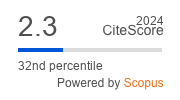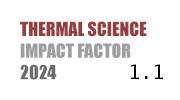THERMAL SCIENCE
International Scientific Journal
Thermal Science - Online First
online first only
Influence of porous media parameters on isothermal piston compression system
ABSTRACT
Compressed air energy storage is considered a promising one to serve as high energy capacity and power rating energy storage systems. As a crucial part, efficient compressors are needed to realize a high compression efficiency. An isothermal piston composed of a solid-piston and porous media is highly effective in achieving efficient near-isothermal compression. The large heat transfer area between the porous media and the air can effectively improve the compression efficiency. Specific surface area and porosity are two key parameters of a porous media and their influence on the performance of isothermal piston compression system is analyzed. Geometric characteristics of porous media is investigated and the flow resistance model is established. The influence of the two key parameters of porous media on resistance is discussed, and a comprehensive energy conservation performance assessment of the isothermal piston is analyzed. The results show that when the porosity is maintained at 0.92 and the specific surface area increases from 860 m-1 to 2980 m-1, the total work of the isothermal piston system decreases by 14.6×103 J/kg and the system efficiency improves by 6.8%, despite the resistance work increasing from 9.4 J/kg to 48.5 J/kg. When the specific surface area is maintained at 2980 m-1 and the porosity increases from 0.6 to 0.92, the resistance work decreases from 17.5×103 J/kg to 57.9 J/kg, the total work of the isothermal piston system reduces by 17.4×103 J/kg, and the system efficiency improves by 8%.
KEYWORDS
PAPER SUBMITTED: 2025-03-15
PAPER REVISED: 2025-05-19
PAPER ACCEPTED: 2025-05-26
PUBLISHED ONLINE: 2025-07-05
- Venkataramani, G., et al., A review on compressed air energy storage - A pathway for smart grid and polygeneration, Renewable and Sustainable Energy Reviews, 62. (2016), pp. 895-907, doi.org/10.1016/j.rser.2016.05.002
- Patil, V.C., et al., Efficiency improvement of liquid piston compressor using metal wire mesh for near-isothermal compressed air energy storage application, Journal of Energy Storage, 28. (2020), p. 101226, doi.org/10.1016/j.est.2020.101226
- Budt, M., et al., A review on compressed air energy storage: Basic principles, past milestones and recent developments, Applied energy, 170. (2016), pp. 250-268, doi.org/10.1016/j.apenergy.2016.02.108
- Olabi, A., et al., Compressed air energy storage systems: Components and operating parameters-A review, Journal of Energy Storage, 34. (2021), p. 102000, doi.org/10.1016/j.est.2020.102000
- Jankowski, M., et al., Status and Development Perspectives of the Compressed Air Energy Storage (CAES) Technologies—A Literature Review, Energies, 17. (2024), 9, p. 2064, doi.org/10.3390/en17092064
- Zhang, X., et al., Advanced Compressed Air Energy Storage Systems: Fundamentals and Applications, Engineering. (2024), pp. 246-269, doi.org/10.1016/j.eng.2023.12.008
- Foley, A.,I.D.J.E. Lobera, Impacts of compressed air energy storage plant on an electricity market with a large renewable energy portfolio, Energy, 57. (2013), pp. 85-94, doi.org/10.1016/j.energy.2013.04.031
- Zhou, S.-W., et al., An Analytical Solution for Mechanical Responses Induced by Temperature and Air Pressure in a Lined Rock Cavern for Underground Compressed Air Energy Storage, Rock Mechanics and Rock Engineering, 48. (2015), 2, pp. 749-770, doi.org/10.1007/s00603-014-0570-4
- Zhou, S.-W., et al., Numerical simulation for the coupled thermo-mechanical performance of a lined rock cavern for underground compressed air energy storage, Journal of Geophysics and Engineering, 14. (2017), 6, pp. 1382-1398, doi.org/10.1088/1742-2140/aa7bd9
- Chen, H., et al., Thermodynamic analysis of an open type isothermal compressed air energy storage system based on hydraulic pump/turbine and spray cooling, Energy Conversion and Management, 204. (2020), p. 112293, doi.org/10.1016/j.enconman.2019.112293
- Qin, C.,E. Loth, Simulation of spray direct injection for compressed air energy storage, Applied Thermal Engineering, 95. (2016), pp. 24-34, doi.org/10.1016/j.applthermaleng.2015.11.008
- Dooner, M.,J. Wang, 14 - Compressed-Air Energy Storage, in: Future Energy (Third Edition), (Ed., T.M. Letcher), Elsevier. 2020, pp. 279-312, doi.org/10.1016/B978-0-08-102886-5.00014-1
- Gouda, E.M., et al., Review on Liquid Piston technology for compressed air energy storage, Journal of Energy Storage, 43. (2021), p. 103111, doi.org/10.1016/j.est.2021.103111
- Ren, T., et al., Performance analysis of an isothermal piston in the case of air compression, Case Studies in Thermal Engineering, 50. (2023), p. 103485, doi.org/10.1016/j.csite.2023.103485
- Patil, V.C., et al., Experimental investigation of water spray injection in liquid piston for near-isothermal compression, Applied Energy, 259. (2020), p. 114182, doi.org/10.1016/j.apenergy.2019.114182
- Ramakrishnan, K.R., et al. Temperature abatement using hollow spheres in liquid piston compressor for Ocean Compressed Air Energy Storage system, OCEANS 2016 MTS/IEEE Monterey,2016, pp. 1-5, doi.org/10.1109/OCEANS.2016.7761341
- Zhang, C., et al., Design analysis of a liquid-piston compression chamber with application to compressed air energy storage, Applied Thermal Engineering, 101. (2016), pp. 704-709, doi.org/10.1016/j.applthermaleng.2016.01.082
- Ren, T., et al., Influence of Rotational Speed on Isothermal Piston Compression System, Entropy, 25. (2023), 4, p. 644, doi.org/10.3390/e25040644
- Ren, T., et al., Experiments on Air Compression with an Isothermal Piston for Energy Storage, Energies, 12. (2019), 19, p. 3730, doi.org/10.3390/en12193730
- Ren, T., et al., A Novel Isothermal Compression Method for Energy Conservation in Fluid Power Systems, Entropy, 22. (2020), 9, p. 1015, doi.org/10.3390/e22091015
- Wieberdink, J., et al., Effects of porous media insert on the efficiency and power density of a high pressure (210 bar) liquid piston air compressor/expander - An experimental study Applied Energy, 212. (2018), pp. 1025-1037, doi.org/10.1016/j.apenergy.2017.12.093
- Yan, B., et al., Experimental study of heat transfer enhancement in a liquid piston compressor/expander using porous media inserts, Applied energy, 154. (2015), pp. 40-50, doi.org/10.1016/j.apenergy.2015.04.106
- Zhou, H., et al., Interrupted plate porous media design for ionic liquid-type liquid piston hydrogen compressor and analysis of the effect on compression efficiency, Journal of Energy Storage, 51. (2022), p. 104410, doi.org/10.1016/j.est.2022.104410
- Dukhan, N.,C.A.J.J.o.P.M. Minjeur, A two-permeability approach for assessing flow properties in metal foam, Journal of Porous Materials, 18. (2011), pp. 417-424, gb.chinamzb.com/productd/1002590133123895296.html
- Sivanesapillai, R., et al., Transition of effective hydraulic properties from low to high Reynolds number flow in porous media, Geophysical Research Letters, 41. (2014), 14, pp. 4920-4928, doi.org/10.1002/2014GL060232

